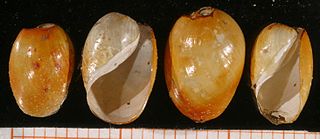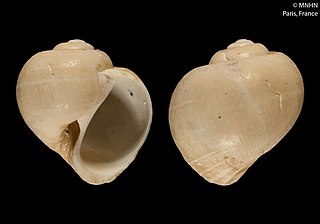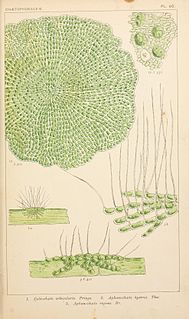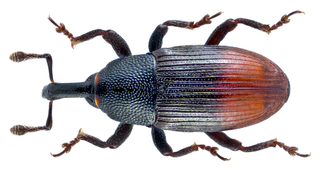Related Research Articles

Ceiba is a genus of trees in the family Malvaceae, native to tropical and subtropical areas of the Americas and tropical West Africa. Some species can grow to 70 m (230 ft) tall or more, with a straight, largely branchless trunk that culminates in a huge, spreading canopy, and buttress roots that can be taller than a grown person. The best-known, and most widely cultivated, species is Kapok, Ceiba pentandra, one of several trees called kapok.

Bulla is a genus of medium to large hermaphrodite sea snails, shelled marine opisthobranch gastropod molluscs. These herbivorous snails are in the suborder Cephalaspidea, headshield slugs, and the order Opisthobranchia.

Akera is a marine genus of sea hare in the family Akeridae, known from the late Callovian (Jurassic) to the recent periods.

Cicindela, commonly known as common tiger beetles are generally brightly colored and metallic beetles, often with some sort of patterning of ivory or cream-colored markings. They are most abundant and diverse in habitats very often near bodies of water with sandy or occasionally clay soils; they can be found along rivers, sea and lake shores, sand dunes, around dry lakebeds, on clay banks, or woodland paths.

Cothurnocystis is a genus of small enigmatic echinoderms that lived during the Ordovician. Individual animals had a flat boot-shaped body and a thin rod-shaped appendage that may be a stem, or analogous to a foot or a tail. Fossils of Cothurnocystis species have been found in Nevada, Scotland, Czech Republic, France and Morocco.
Wrayanna soluta is a species of sea snail, a marine gastropod mollusk in the family Assimineidae. This species is endemic to Micronesia.
Wrayanna is a genus of minute, salt marsh snails with an operculum, aquatic gastropod mollusks, or micromollusks, in the family Assimineidae.

Falsilunatia is a genus of sea snails, marine gastropod molluscs in the subfamily Globisininae of the family Naticidae, which are known as moon snails or moon shells.

Coleochaete is a genus of parenchymatous charophyte green algae in the order Coleochaetales. They are haploid, reproduce both sexually and asexually, and have true multicellular organisation, with plasmodesmata communicating between adjacent cells. The plants form flat, sprawling discs on solid surfaces in freshwater streams worldwide, usually as epiphytes on aquatic plants or growing on the surface of stones. They are seen as one of two most probable sister groups to land plant species, the second candidate group being the Characeae. The issue is still not resolved. As they show some of the earliest and simplest features of multicellular plant growth, they are ideal model organisms in the field of synthetic biology. They are easy to culture and techniques that have been used to study Arabidopsis thaliana are now being applied to Coleochaete.

Neptunea is a genus of large sea snails, marine gastropod mollusks in the family Buccinidae, the true whelks.

Setia is a genus of minute sea snails, marine gastropod mollusks or micromollusks in the family Rissoidae.
Cycloscala is a genus of predatory sea snails, marine prosobranch gastropod mollusks in the family Epitoniidae, commonly known as wentletraps.

Pogonocherini is a tribe of longhorn beetles of the subfamily Lamiinae.
Soluta may refer to:

Baris is a genus of weevils.

Paraglenea fortunei is a species of beetle in the family Cerambycidae. It was described by Saunders in 1853, originally under the genus Glenea. It is known from Taiwan, China, North Korea, South Korea, and Vietnam, and has been introduced into Japan. It feeds on Cinnamomum camphora, Boehmeria nivea, Hibiscus syriacus, Morus alba, and Triadica sebifera.

Draeculacephala is a genus of leafhoppers. It is one of the most common and widespread genera of leafhoppers in the New World. There are at least 25 described species in Draeculacephala.

Soluta is an extinct class of echinoderms that lived from the Middle Cambrian to the Early Devonian. The class is also known by its junior synonym Homoiostelea. Soluta is one of the four "carpoid" classes, alongside Ctenocystoidea, Cincta, and Stylophora, which made up the obsolete subphylum Homalozoa. Solutes were asymmetric animals with a stereom skeleton and two appendages, an arm extending anteriorly and a posterior appendage called a homoiostele.
References
- ↑ Biolib.cz - Soluta gramineoides. Retrieved on 8 September 2014.